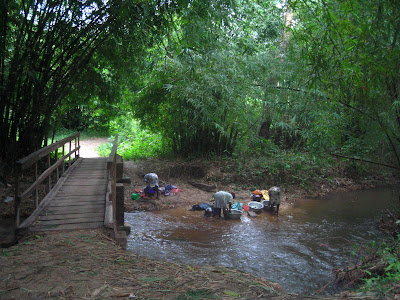Hospitality is arguably the selling point for Ghana.
After four hours of riding north in cramped tro tros(vans) we arrived in Kwahu Tafo. We had not made any arrangements for accommodations and the sun was beginning to set. I noticed two obrunis (white folk) and we decided to introduce ourselves. We asked if they knew anything about a place to stay...
fast forward two minutes...
A very nice SUV rolls up with two individuals who we learn are Humphrey, the Chief of Development and Prince Boat. Humphrey Barclay is a very well-to-do British TV series producer, who has founded the organization Friends of Tafo. He has done wonders for the community - established a library, brought computers to the schools, increased sanitation, etc, etc. He whisked us away to his palace and gave us a cold drink and told us a great deal about the area. Then, Boat took us all around the little local hot spots that evening.
We could hardly believe our luck. At times, it can be frustrating to have everyone acknowledge you because of your race. But really, it is so nice to be acknowledged as a visitor and given the royal treatment.
The next morning Gustav and I wandered through town with a faint idea of what we wanted to do - Adventure and hike. We had heard that the Buruku Rock Pillar Shrine was a good day hike and it certainly looked spectacular off in the distance.
Ghanaians believe that the natural and spiritual world are very tightly knit. Thus, whenever the natural world exemplifies any mark of being extraordinary it may be deemed sacred. The rock pillar is sacred and home to a God who distastes yams. Story goes that it used to be twice as tall, but one day an ant holding a yam climbed atop Buruku, and lo and behold the top half crumbled down! What a mighty, mighty ant.
We wandered around town asking for directions, and giving the abridged version of our life story to every Ghanaian we passed (everyone asks
"Whatareyoudoinghere?Whereareyoufrom?Whatisyourname?Whereareyougoing?"). This makes getting lost in Ghana nearly impossible. I had my mind set on roughing it through the bush alone. Luckily, I did not get my way and a young village boy decided to be our guide.
Young boy - "Where are you going?"
Us - "Buruku Rock Pillar Shrine."
Young boy - "OK, lets go."
Once we left the road, we found it to be quite difficult to find our way. No worry, we ran across two other young boys that decided to join us on our hike. Also, they had machetes, which made working our way through the bush a bit easier. We got to this cliff edge, where the boys were determined to find a way for us to get down. A jump here, slide there, grab that branch (hope to God it doesn't break) and we were down. It was hot out, we got lots of cuts on our arms and legs, but damn were we determined to get to Buruku. Without the help of those young boys, I'm not quite sure how we would have made our way.
Once we reached Buruku, Gustav poured some drink as an offering, we were told if we didn't do this then our cameras would be spoiled. From the top we could see Lake Volta and a few small villages; it was a beautiful sight. It was funny to think that we had struggled so much to get up to where we were, since it looked like a relatively simple climb. Not having a proper path had proven to be a bit treacherous at times. Looking down the bush did not seem to be that tall or thorny and the slight slope did not seem to be slippery, but looks can be deceiving.
It was just the adventure I had been craving.
 |
| Contemplating our Path |

















































